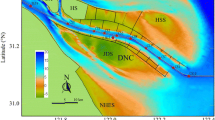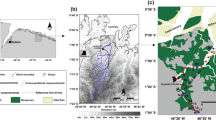Abstract
Data are presented from several experiments in the freshwater-saltwater interface (FSI) region of the Tamar Estuary. Longitudinal surveys of salinity and suspended particulate matter (SPM) at high water showed that the location of the FSI could be predicted in terms of a power-law regression with freshwater runoff. Longitudinal transects also were surveyed over periods of several hours. The FSI was observed to advect into the region on the flood with strong vertical mixing. After high water, stratification became intense as fresher water ebbed in the surface layers. The near-bed water in the stratified region began to ebb between 2 h and 3 h before low water. A model of the vertical structure of longitudinal currents showed that the enhanced stratification on the ebb, coupled with the longitudinal density gradient, partly produced this long period of slack, near-bed currents following high water. A strong turbidity maximum (TM) occurred during spring tides and was located slightly up-estuary of the FSI at high water. Longitudinal transects during a period of low freshwater runoff and large neap tide showed that at the start of the flood the TM was associated with the FSI region. As the FSI advected up-estuary on the flood there was considerable resuspension of sediment at the FSI. Some of this SPM moved with the FSI and reached the limit of saline intrusion, where it formed a slowly-eroding TM as particles settled during the long, high-water slack period. As the near-bed currents increased on the ebb and the FSI moved down-estuary, strong vertical mixing and resuspension of recently deposited sediment occurred in the unstratified water behind the FSI and the associated TM advected down-estuary. Additional effects were present with stronger tides and increased runoff.
Similar content being viewed by others
Literature Cited
Allen, G. P., G. Sauzay, P. Castaing, andJ. M. Jouanneau. 1977. Transport and deposition of suspended sediment in the Gironde Estuary, France, p. 63–81.In M. Wiley (ed.), Estuarine Processes. Academic Press, New York.
Allen, G. P., J. C. Salomon, P. Bassoulet, Y. du Penhoat, andC. de Grandpre. 1980. Effects of tides on mixing and suspended sediment transport in macrotidal estuaries.Sedimentary Geology 26:69–90.
Bale, A. J., A. W. Morris, andR. J. M. Howland. 1985. Seasonal sediment movement in the Tamar Estuary.Oceanologica Acta 8:1–16.
Chatwin, P. C. 1976. Some remarks on the maintenance of the salinity distribution in estuaries.Estuarine and Coastal Marine Science 4:555–566.
Dronkers, J. 1986. Tide-induced residual transport of fine sediment, p. 228–244.In J. van de Kreeke (ed.), Physics of Shallow Estuaries and Bays Lecture Notes on Coastal and Estuarine Studies, Vol. 16. Springer-Verlag, New York.
Dronkers, J., andJ. van de Kreeke. 1986. Experimental determination of salt intrusion mechanisms in the Volkerak Estuary.Netherlands Journal of Sea Research 20:1–19.
Dyer, K. R. 1986. Coastal and Estuarine Sediment Dynamics. John Wiley, Chichester. 342 p.
Festa, J. F., andD. V. Hansen. 1976. A two-dimensional model of estuarine circulation: The effects of altering depth and river discharge.Estuarine and Coastal Marine Science 7:347–359.
Festa, J. F., andD. V. Hansen. 1978. Turbidity maxima in partially mixed estuaries: A two-dimensional numerical model.Estuarine and Coastal Marine Science 7:347–359.
Geyer, W. R. 1993. The importance of stratification on the formation of the turbidity maximum.Estuaries 16:113–125.
Grabemann, I., andG. Krause. 1989. Transport processes of suspended matter derived from time-series in a tidal estuary.Journal of Geophysical Research 94:14373–14379.
Hamblin, P. F.. 1989. Observations and model of sediment transport near the turbidity maximum of the upper Saint Lawrence Estuary.Journal of Geophysical Research 94:14419–14428.
Kirby, R. A. andW. R. Parker. 1977. The physical characteristics and environmental significance of fine-sediment suspensions in estuaries, p. 110–120.In C. B. Officer (ed.), Estuaries, Geophysics and the Environment. National Academy Press, Washington, D.C.
Kranenburg, C. 1986. A time scale for long-term salt intrusion in well-mixed estuaries.Journal of Physical Oceanography 16: 1329–1331.
Lepage, S. andR. G. Ingram. 1986. Salinity intrusion in the Eastmain River estuary following a major reduction of freshwater input.Journal of Geophysical Research 91:909–915.
Munk, W. H. andE. R. Anderson. 1948. Note on the Theory of the thermocline.Journal of Marine Research 7:276–295.
Oey, L. Y. 1984. On steady salinity distribution and circulation in partially mixed and well-mixed estuaries.Journal of Physical Oceanography 14:629–645.
Officer, C. B. 1981. Physical dynamics of estuarine suspended sediments.Marine Geology 40:1–14.
Officer, C. B. andM. N. Nichols. 1980. Box model application to a study of suspended sediment distributions and fluxes in partially mixed estuaries, p. 329–340.In V. S. Kennedy (ed.), Estuarine Perspectives. Academic Press, London.
Peterson, D. H., T. J. Conomos, W. W. Broenkow, andP. C. Doherty. 1975. Location of the non-tidal current null zone in northern San Francisco Bay.Estuarine and Coastal Marine Science 3:1–11.
Posmentier, E. S. andJ. W. Rachlin. 1976. Distribution of salinity and temperature in the Hudson Estuary.Journal of Physical Oceanography 6:775–777.
Prandle, D. 1981. Salinity intrusion in estuaries.Journal of Physical Oceanography 11:1311–1324.
Prandle, D. 1985. On salinity regimes and the vertical struc-ture of residual flows in narrow tidal estuaries.Estuarine, Coastal and Shelf Science 20:615–635.
Sheng, Y. P. andC. Villaret. 1989. Modeling the effect of suspended sediment stratification on bottom exchange processes.Journal of Geophysical Research 94:14429–14444.
Simpson, J. H. andR. A. Nunes. 1981. The tidal intrusion front: An estuarine convergence zone.Estuarine, Coastal and Shelf Science 13:257–266.
Thatcher, M. L. andD. R. F. Harleman. 1981. Long-term salinity calculation in Delaware Estuary.Journal of the Environmental Engineering Division of the American Society of Civil Engineers 1:11–27.
Thatcher, M. L. andT. O. Najarian 1983. Transient hydrodynamic and salinity simulations in the Chesapeake Bay network.Estuaries 6:356–363.
Uncles, R. J., R. C. A. Elliott, andS. A. Weston. 1985a. Observed fluxes of water, salt and suspended sediment in a partly mixed estuary.Estuarine, Coastal and Shelf Science 20: 147–167.
Uncles, R. J., R. C. A. Elliott, andS. A. Weston 1985b. Dispersion of salt and suspended sediment in a partly mixed estuary.Estuaries 8:256–269.
Uncles, R. J., R. C. A. Elliott, andS. A. Weston. 1985c. Lateral distributions of water, salt and sediment transport in a partly mixed estuary, p. 3067–3077.In B. L. Edge (ed.), Proceedings of the 19th International Conference on Coastal Engineering. Chapter 204. American Society of Civil Engineers, New York.
Uncles, R. J. andI. R. Joint. 1983. Vertical mixing and its effects on phytoplankton growth in a turbid estuary.Canadian Journal of Fisheries and Aquatic Sciences 40:221–228.
Uncles, R. J. andJ. A. Stephens. 1989. Distributions of suspended sediment at high water in a macrotidal estuary.Journal of Geophysical Research 94:14395–14405.
Uncles, R. J. andJ. A. Stephens. 1990a. Salinity stratification and vertical shear transport in an estuary, p. 137–150.In R. T. Cheng (ed.), Residual Currents and Long-Term Transport. Coastal and Estuarine Studies, Vol. 38. Springer-Verlag, New York.
Uncles, R. J. andJ. A. Stephens. 1990b. The structure of vertical current profiles in a macrotidal, partly-mixed estuary.Estuaries 13:349–361.
Uncles, R. J., J. A. Stephens, and M. L. Barton. 1991. The nature of near-bed currents in the upper reaches of an estuary, p. 43–47.In M. Elliott and J.-P. Ducrotoy (eds.), Estuaries and Coasts, Spatial and Temporal Comparisons. Olsen and Olsen—International Symposium Series, Fredensborg, Denmark.
Uncles, R. J., J. A. Stephens, andM. L. Barton. 1992. Observations of fine-sediment concentrations and transport in the turbidity maximum region of an estuary, p. 255–276.In D. Prandle (ed.) Dynamics and Exchanges in Estuaries and the Coastal Zone. Proceedings of the Gregynog Conference, Wales, United Kingdom, July 1990. Coastal and Estuarine Studies, AGU, Washington, D.C.
Uncles, R. J., J. A. Stephens, R. H. Bruce, C. D. Barrett, and N. J. Bloomer 1989. Observations of temporal variability in a partly mixed estuary using a new instrument package, p. 151–158.In J. McManus and M. Elliott (eds.), Developments in Estuarine and Coastal Study Techniques. Olsen and Olsen—International Symposium Series, Fredensborg, Denmark.
Uncles, R. J., J. A. Stephens, andT. Y. Woodrow. 1988. Seasonal cycling of estuarine sediment and contaminant transport.Estuaries 11:108–116.
West, J. R., K. O. K. Oduyemi, A. J. Bale andA. W. Morris. 1990. The field measurement of sediment transport parameters in estuaries.Estuarine, Coastal and Shelf Science 30:167–183.
West, J. R., K. O. Oduyemi, andK. Shiono 1991. Some observations on the effect of vertical density gradients on estuarine turbulent transport processes.Estuarine, Coastal and Shelf Science 32:365–384.
West, J. R. andA. Y. A. Sangodoyin. 1991. Depth-mean tidal current and sediment concentration relationships in three partially mixed estuaries.Estuarine, Coastal and Shelf Science 32:141–160.
Wolanski, E., J. Chappell, P. Ridd, andR. Vertessy 1988. Fluidization of mud in estuaries.Journal of Geophysical Research 93:2351–2361.
Author information
Authors and Affiliations
Rights and permissions
About this article
Cite this article
Uncles, R.J., Stephens, J.A. The freshwater-saltwater interface and its relationship to the turbidity maximum in the Tamar Estuary, United Kingdom. Estuaries 16, 126–141 (1993). https://doi.org/10.2307/1352770
Received:
Accepted:
Issue Date:
DOI: https://doi.org/10.2307/1352770




